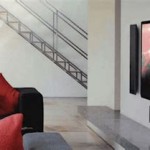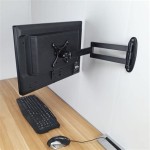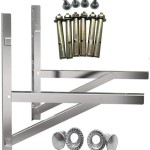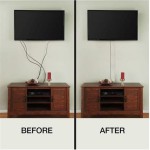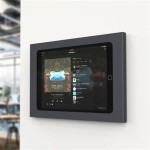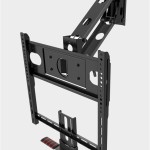How High Should a Wall-Mounted TV Be?
Determining the optimal height for a wall-mounted television requires a nuanced understanding of viewing angles, seating arrangements, and individual preferences. A television mounted too high or too low can lead to neck strain, eye fatigue, and a diminished viewing experience. Consequently, careful consideration of these factors is crucial before drilling any holes or securing the mounting bracket.
The primary goal is to position the television at a height where the viewer's eyes naturally fall on the screen when seated in their typical viewing posture. This minimizes the need to crane the neck up or down, preventing discomfort and promoting a more immersive experience. While there is no universally applicable "magic number," general guidelines exist that can be adapted to specific circumstances.
Several elements influence the ideal mounting height, including the size of the television, the distance between the viewer and the screen, the height of the seating arrangement, and the overall aesthetics of the room. These factors must be carefully assessed to ensure a comfortable and visually appealing installation.
The 42-Inch Rule: A Starting Point
A common rule of thumb suggests that the center of the television screen should be approximately 42 inches from the floor. This recommendation is based on the average eye level of a person sitting on a standard sofa or chair. However, this is merely a starting point and should be adjusted based on individual circumstances. For instance, if the seating is lower than average, the television may need to be mounted lower as well.
To refine this guideline, consider the following steps: first, sit in your usual viewing position. Second, have someone measure the distance from the floor to your eyes. This measurement represents your ideal eye level. Finally, calculate the distance from the bottom of your television screen to the center of the screen. Subtract this distance from your eye level to determine the optimal height for the bottom of the television.
This method provides a more personalized approach to determining the mounting height, taking into account individual variations in height and seating preferences. While the 42-inch rule offers a general benchmark, this refined approach ensures a more comfortable and ergonomically sound viewing experience.
Considering Screen Size and Viewing Distance
The size of the television screen and the distance at which it is viewed significantly influence the perceived optimal height. A larger screen viewed from a shorter distance may require a slightly lower mounting position to ensure that the entire screen is comfortably within the viewer's field of vision. Conversely, a smaller screen viewed from a greater distance may necessitate a slightly higher mounting position to compensate for the reduced visual impact.
A generally accepted guideline is that the viewing distance should be approximately 1.5 to 2.5 times the diagonal screen size. For example, a 55-inch television would ideally be viewed from a distance of approximately 82.5 to 137.5 inches (6.9 to 11.5 feet). If the viewing distance is significantly shorter or longer than this range, adjustments to the mounting height may be necessary.
To optimize the viewing experience based on screen size and viewing distance, consider the following: If the viewing distance is relatively short, lower the mounting height to ensure that the viewer can comfortably take in the entire screen without straining their neck. If the viewing distance is relatively long, raise the mounting height slightly to compensate for the reduced visual impact and improve visibility.
In addition to screen size and viewing distance, the resolution of the television should also be considered. A higher resolution television may benefit from a closer viewing distance, which could necessitate a lower mounting height.
Accounting for Seating Arrangements and Ergonomics
The type of seating arrangement in the viewing area plays a crucial role in determining the optimal mounting height. Sofas, chairs, and recliners all offer different seating heights, which directly impact the viewer's eye level. Furthermore, the posture adopted while using these seating options can also vary, influencing the ideal viewing angle.
When mounting a television in a room with multiple seating options, it is important to consider the average eye level across all seating positions. Alternatively, the mounting height can be optimized for the most frequently used seating option. If the seating arrangement includes recliners, it is essential to account for the reclined position, as this will significantly alter the viewer's eye level.
To ensure an ergonomically sound viewing experience, consider the following factors: The mounting height should allow the viewer to maintain a neutral head and neck posture, minimizing the need to tilt the head up or down. The viewing angle should be within a comfortable range, typically between 0 and 15 degrees below eye level. The television should be positioned at a distance that allows the viewer to comfortably see the entire screen without straining their eyes.
Proper ergonomic considerations are paramount for long-term viewing comfort. Ignoring these factors can lead to chronic neck pain, eye fatigue, and other musculoskeletal issues. Therefore, it is essential to prioritize ergonomics when determining the mounting height for a wall-mounted television.
Considerations for Bedroom TV Mounting
Mounting a television in a bedroom presents unique challenges compared to a living room or entertainment area. The primary viewing position in a bedroom is often lying down or propped up in bed, which significantly alters the viewer's eye level and viewing angle. Consequently, the mounting height in a bedroom typically needs to be higher than in other rooms.
When mounting a television in a bedroom, it is crucial to simulate the typical viewing position to determine the optimal height. Lie in bed in your usual posture and have someone measure the distance from the mattress to your eyes. This measurement represents your ideal eye level while in bed. Subtract the distance from the bottom of your television screen to the center of the screen from your eye level to determine the optimal height for the bottom of the television in the bedroom.
In addition to eye level, consider the following factors when mounting a television in a bedroom: The television should be angled slightly downward to compensate for the elevated viewing position. The mounting bracket should be capable of tilting to allow for adjustments to the viewing angle. The television should be positioned at a distance that allows the viewer to comfortably see the entire screen without straining their eyes.
Bedroom televisions often require a more customized approach to mounting due to the unique viewing position. Prioritizing comfort and ergonomic considerations is essential to ensure a relaxing and enjoyable viewing experience.
Aesthetic Considerations and Cable Management
While functionality and ergonomics are paramount, aesthetic considerations also play a role in determining the optimal mounting height. The television should be positioned in a way that complements the overall design of the room and enhances the viewing experience. Cable management is equally important, as unsightly cables can detract from the aesthetic appeal of the installation.
When considering aesthetics, balance the functional requirements of the mounting height with the visual impact of the television on the room. The television should not dominate the space or appear out of place. Consider the placement of other furniture and décor in the room to ensure a cohesive and visually appealing design.
Effective cable management is crucial for maintaining a clean and organized appearance. Conceal cables within the wall using in-wall cable management kits, or use cable sleeves and ties to bundle and organize exposed cables. Consider using a power outlet relocation kit to position the power outlet behind the television, minimizing the visibility of power cords.
A well-executed wall-mounted television installation should seamlessly blend functionality, ergonomics, and aesthetics. By carefully considering all of these factors, it is possible to create a viewing experience that is both comfortable and visually appealing.
Ultimately, finding the "perfect" height for a wall-mounted TV involves careful assessment, calculation, and a bit of trial and error. Spending the time to optimize the installation ensures a comfortable and enjoyable viewing experience for years to come. Consider consulting with professional installers for personalized advice and assistance.

At What Height Should Your Flat Screen Be Mounted Nextdaytechs On Site Technical Servicesnextdaytechs Services

How High Should A Tv Be Mounted The Plug Hellotech

How High Should Your Tv Be Mounted Reviews By Wirecutter

Tv Mounting Height Calculator

How High To Mount A Tv In The Home Cepro

Wall Mounted Tvs What Is The Best Height To Mount A Livingroom Tv Nicoll Stewart

Heightfinder Sanus

How High To Mount Your Tv For The Perfect Viewing Experience

News Tv Wall Mount Installation Tips For The Experts Mhtg

How High Should A Tv Be Mounted The Plug Hellotech

